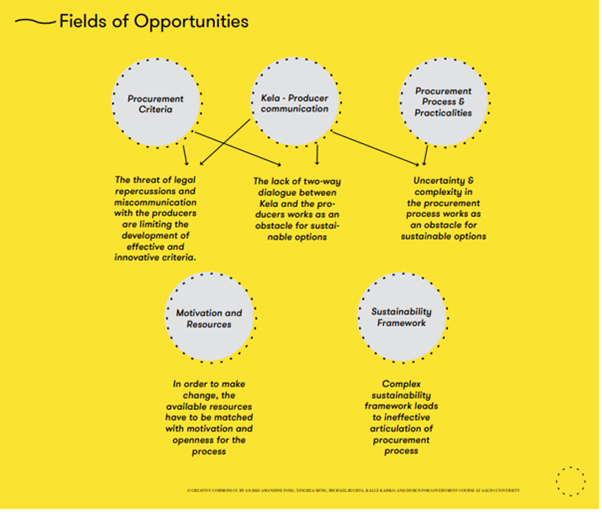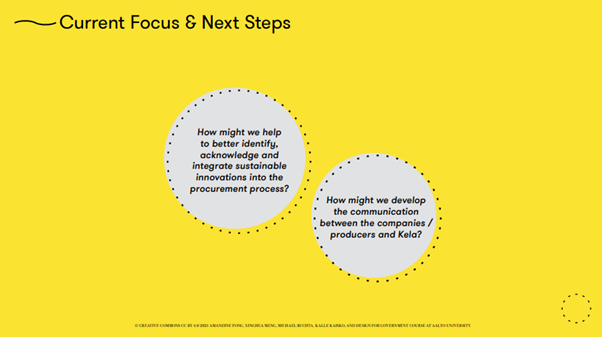This blog post reports on work-in-progress within the DfG course! The post is written by the group dealing with the Ministry of Economic Affairs and Employment’s brief on ‘Reducing the carbon footprint of procurement services’.
Group 2A: Xinghua Meng, Kalle Kaisko, Michael Buchta from the Creative Sustainability program and Amandine Fong from the Collaborative and Industrial Design program.
YOU ASKED FOR IT – WE DELIVER
To begin, we want to say that we hear you and thus we’ll introduce our team. Below you can find a picture where we reenacted the conversation that helped us to define our focus area: procurer-producer relationship, procurement process and procurement practicalities.

For the last three weeks, we have been busy doing research. Together with the other groups working with the same brief, we have conducted 20 interviews and gone through several documents and reports to get a better understanding of what we are facing. We have utilized design tools like systems maps and affinity diagrams to identify key problem areas and fields of opportunities in the project.
WHAT DID WE DISCOVER?
Our research culminated on Monday, March 29th when we presented our initial findings to Kela and the other stakeholders. From the research material, we have identified five themes and five insights, which we call fields of opportunities, related to those themes. We noticed that the current procurement criteria don’t support innovation or sustainable options, the dialogue between Kela and the producers is blatantly insufficient and that the uncertainties in the procurement process prevent producers from offering the best available products to the bidding contest. Additionally, even with the best possible resources, no change will happen unless the procurement unit is open for change and motivated and that the complexity and the vastness of the sustainability framework is too much for one procurement officer to grasp. The first three themes are tightly interlinked as you can see from the picture below.

MULTIPLE PERSPECTIVES – MULTIPLE OPINIONS
Coming back to the interviews, we were fortunate to hear from multiple perspectives around the topic. Let’s use the procurement contract’s length as an example. Here are a few quotes from different stakeholders:
“One year contract is a benefit for suppliers to follow up on cost changes“
– KelaLonger contracts? “Yes. Depends on the years, not 5 or 10 but at least 2 years. Would reduce our work by half.”
– Producers”Doing procurement yearly is problematic, since it’s difficult to get the sustainable fabric in small patches.“
– Producers“Optimal interval for procurement process is 2-3 years. Doing it every year is more than what’s necessary.”
– Hansel“In principle it [yearly procurement process] is a good thing, since it allows Kela to accumulate experience over the years and make changes yearly. Possibility to iterate.”
– VTT
By just reading these five quotes it’s quite evident that the stakeholders have totally different understanding on what is the optimal interval for the tendering process. We found the misalignment between Kela and the producers especially interesting. These quotes and interviews also demonstrated for us that with better communication between the stakeholders, problems like this could be avoided.
MAPPING THE SYSTEM
We used the CATWOE method to get a better understanding and to identify crucial clusters in the system. This helped us to find our focus area and discover which organizations and persons would be most important for us to interview. By defining the focus area, we were also able to come up with better targeted and formulated questions for the interviewees. As creating the systems map became very handy for us, we encourage you to use such tools when facing similar problems and situations. Lastly, before you take a look at our map, I want to underline that the map is still a work in progress and we’ll be updating it as we learn more.

WE ARE ON THE RIGHT TRACK
The feedback we received from Kela and the other stakeholders that participated in the Mid-term review encouraged us that we are on to something. Next, we want to learn more about creating conditions that boost sustainable innovation in the procurement process and come up with solutions to enable a two-way dialogue between Kela (procurers in general) and the producers. But before we dive into the world of solutions, we are going to take a relaxing and well earned Easter break.

